Do you know how Reviews & Ratings affect your ASO (App Store Optimization)? The majority of Indie Developers don’t.
Tracking, managing, and answering all your App Store Reviews is a time-consuming job. Unfortunately, mobile Devs don’t even know where to start, or even worse, they’re not aware of how crucial it can be to take care of your apps’ or games’ reputation.
In this article, we’ll cover everything related to your ASO Reviews & Ratings for Indie Developers: How they work on Apple App Store and Google Play, what their real impact is, how we can turn bad reviews into positive feedback, and even talk about some tips and strategies to deal with them and improve them.
Learn how to boost your ASO (App Store Optimization) organic reach with the Appodeal articles!
SUMMARY OF CONTENTS
- ASO Ratings vs. ASO Reviews
- The Real Impact on your ASO
- Apple App Store vs. Google Play
- Pro Tips to Improve your ASO Reviews
- Managing your ASO Ratings and Reviews
Differences between ASO Ratings & Reviews
If you think you already know the difference between ratings and reviews, you can safely jump to the next section of this article.
But if you are an Indie Developer launching your mobile app or game for the first time, and this is your first approximation to ASO Ratings & Reviews, you must understand those.

- App Store Ratings are quantitative marks, between 1 to 5, of what users think of your app.
- App Store Reviews are qualitative feedback, and users can write everything they want about your game (unless it’s against the platform guidelines).
It may seem pretty obvious. But after a few years of experience in game jams, conventions, and many conversations, I can tell you that the ASO terms "Ratings" & "Reviews" tend to get mixed quite often.
The real impact of ASO Ratings & Reviews
Your App Store Rating is everywhere
In the search results, at the top of your App Store Product Page, in the “reviews” section, at the splash-screen of your ads, etc.
If you have a bad ASO Rating, users will see that everywhere.

The number of ratings and their score also affects your positioning in the search results in ASO terms. Or, what’s even worse, if your app’s rate is under four stars, users will be able to filter you out of their search results.
If you want a healthy game with a nice flow of organic users, you definitely MUST take care of your App Store Ratings.

ASO Reviews: Size does matter
Reviews have their own section in your App Store Product Page. The impact of ASO Reviews is way, way less significant than ASO Ratings.
On average, “only” 20% of the people get to see the Reviews Section in the Apple App Store when checking a new app or game. In Google Play, this number falls up to 15%.
And on top of that, all these people who scroll down to the reviews section only see three reviews. To read them in full, they have to click on the “more reviews” button. That specific button is only clicked by 1% of the visitors in Apple App Store and 2% in Google Play.
Source of the data: Internal Appodeal Analytics, on June 2021, based on +50.000 indie apps.
Users are not very exposed to Reviews.
BUT! they are highly exposed to the NUMBER of reviews, and it is shown next to your apps’ Rating.
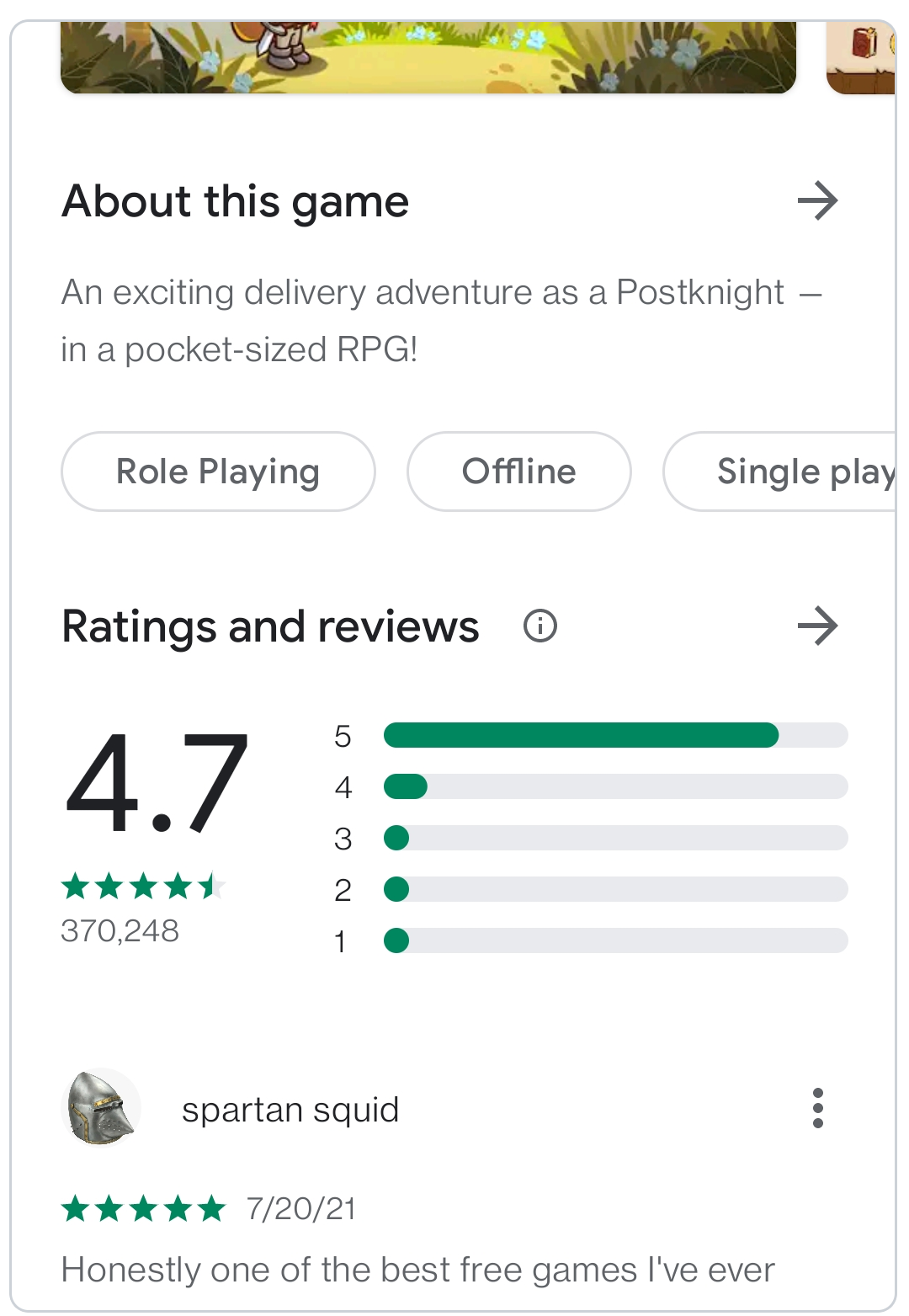
For this reason, and strictly speaking in ASO terms (App Store Optimization), you want a high volume of positive Reviews to your App, “no matter the length or quality of the feedback.”
However, there is life beyond ASO, and Reviews impact other areas of your growth, as we will see in the next section of this article.
ASO Reviews are relevant to Curious and Loyal Users
Now you may be wondering, “If only a small percentage of users will read the reviews, then why the hustle to manage, track and answer them?”
There are several reasons to take care of your ASO Reviews to...
- Turn negative reviews into positive ones,
- Gather feedback & ideas to improve your game in future updates,
- Build a strong community that helps you grow organically (instead of paying campaigns),
- Convert curious but still hesitant visitors to installs (also referred to as the “exploring” type of visitors),
- Turn new players into long-time loyal users,
- Show Apple or Google how engaged you are with the audience - it’s vital as it’s one of the important aspects taken into account for ranking,
- And probably a few more things I’m missing (If you think of any, leave it in the comments!)
We could get into details with all of them, but they are pretty self-explanatory.
Instead, think of the kind of user that will read your ASO Reviews. Take this as an example:

The above mobile game has superb Ratings, lots of reviews. Do you think new players will spend money on it? Do you think users with 15D or even 30D retention will even consider playing or purchasing IAPs, knowing that they will hit a colossal paywall? Do you think the answers are emphatic and solve users’ problems?
Take care of your ASO Reviews. Your (potentially) most valuable users are going to read them.
ASO Reviews & Ratings: Apple App Store vs. Google Play
The Ratings in Apple App Store & Google Play have a lot of similarities.
Ratings are visible on the Search Result page, at the top of the App Store Product Page, and in the Reviews section. While on iOS, the Rating is displayed as a Star system (★★★★☆), on Android, you get to see the rating number (4.3★).
Next to the Ratings, you can see the total number of reviews that your game or app has in both app stores.

And again, in both platforms, very close to the rating and number reviews, the “Install” button.
It is nearly impossible for potential users to miss the average score of your game before deciding to install your app. Maybe on Google Play, due to its GUI, the star-system and total reviews are harder to spot compared to Apple App Store. But still, the chances are high that users find it with ease.
About the Review section inside your App Store Product Page, both platforms feature some of your most representative reviews. Apple selects the featured reviews through an algorithm that we don’t know much about. On the other side, Google Play utilizes NLP (Natural Language Processing) to highlight the reviews with the average rating and keywords most commonly used by your users.

8 Pro Tips to Improve your ASO Reviews:
1. Encourage users to Review your App
Imagine yourself in a restaurant. How many times, when everything is just fine, have you gone to the kitchen to congratulate the chef? Yeah, no one does that.
Mobile users are the same.
If you don’t invite players to rate & review your game in the App Stores, some people will only go to your App Store Page when problems emerge or just to rant.
For this reason, most apps and games tend to prompt users with pop-ups after the tutorial or right after a spectacular event. You can find several examples, such as big wins on casino games, a successful boss battle on fighting games, level completion on arcades, etc.
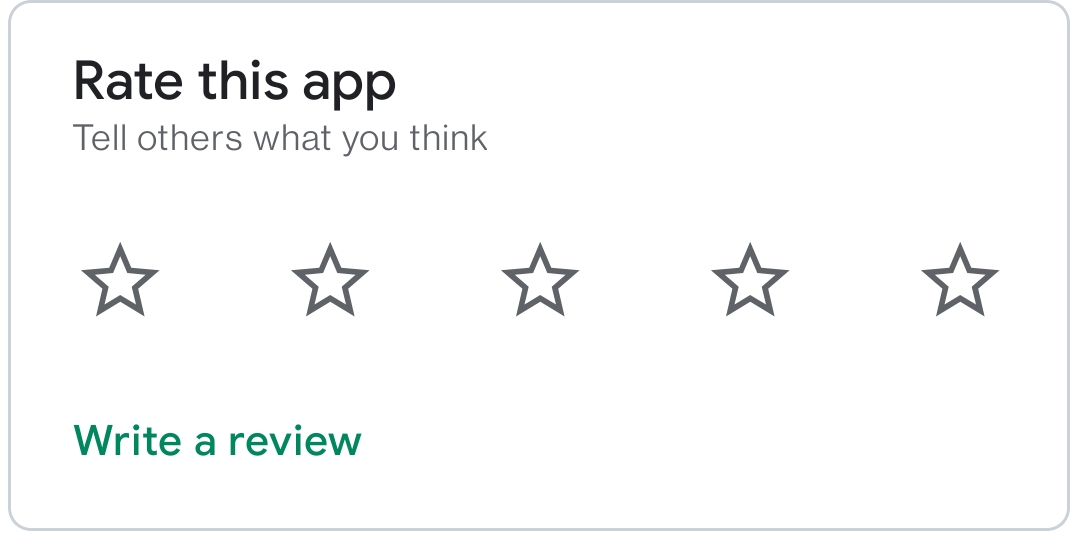
Don’t ask for a review right after the user first installed your app. This player doesn’t have any opinion yet, and most probably, they will ignore the pop-up. Or worse, it will annoy them and make them send a negative review.
Analyze your game and monitor user behavior. Then, create a moment where the user's excitement and happiness are at their maximum, and ask them for that gentle, selfless review of your game.
2. Customizing the Prompt to Review your App
Apple recommends using the “iOS native in-app review request widget” to collect your ASO Reviews and Ratings. According to them, their native widget is less intrusive. Users just need a few seconds to Rate and Review your app, and they remain in it during the whole process.
However, that does not mean that you can’t add a previous Pop-Up before that.
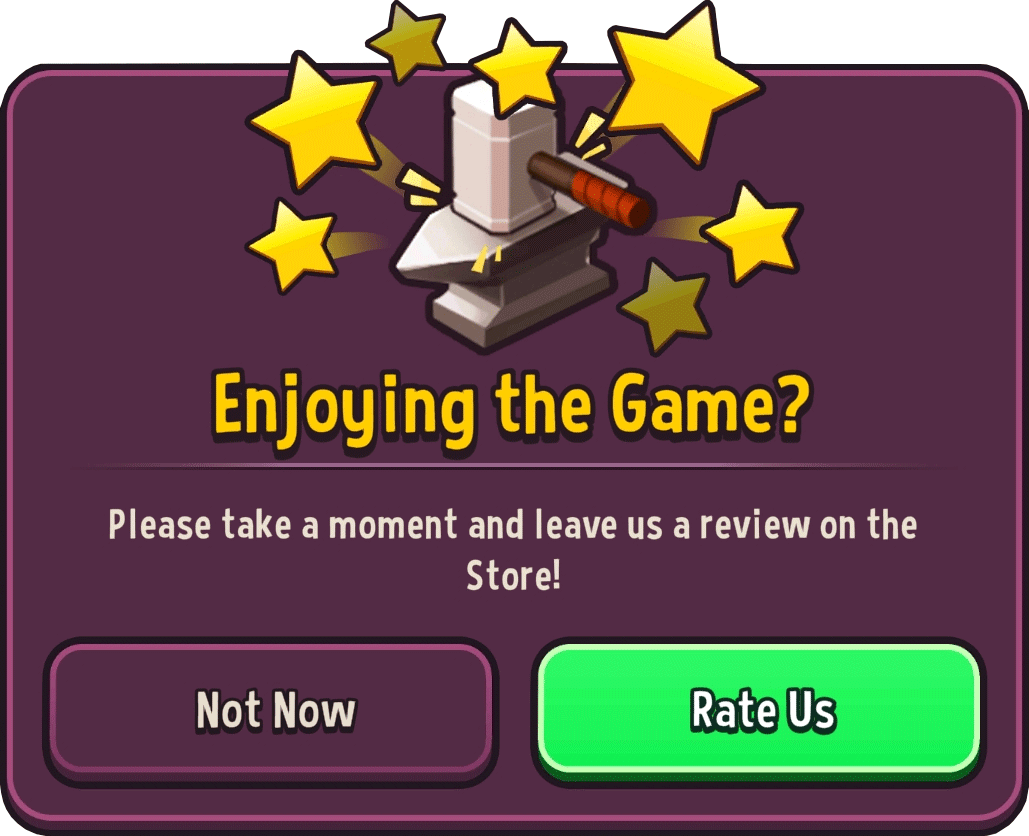
Why would you want that? To filter out those users that are going to send a negative review.
Pro TIP: If a user rates your app with a 1 to 3 star in your customized pop-up, instead of prompting up the iOS native widget afterward, you can open a “Request Ticket” window with your support team.
And the same goes for Google Play.
Also, depending on how you formulate your question, you may get higher ratings. For example, a simple question such as “are you having fun?” will drive higher ratings than “Do you think we’re the most awesome game ever?”
3. Prioritize your ASO Rating Management
Users will leave a rating on your mobile app or game way more often than a review.
Unless you generate strong feelings on users, they won’t spend their valuable time writing a review regardless of whether they love or hate you.
This trend makes it easier for you to monitor your ratings and optimize your game mechanics to push users to rate your product. Check if your score rating is dropping after a recent update or during seasonal events. The sooner you address these issues, the faster it will be for you to recover.
Also, remember that on Google Play, your most recent reviews have a higher value than the old ones. So if you have an average score of 4.6, but you’ve got an average of 3.5 ratings in the last month, this will severely hurt your ASO.
4. Avoid a Rating “Too Good to be True”
Deals that are too good to be true tend to generate disbelief.
The same happens when a mobile app or game in the app stores has a perfect rating: five stars in Apple or a perfect 5.0 in Google Play.

During our analysis, we found that apps have greater chances of success when their app rating is within 4.1 and 4.9.
As long as your mobile game has a rating of 4.0 or above, you will be fine. However, if it falls to 3.9 or lower, your ASO conversion rates will drop. They won’t be featured as much, will get filtered out, and users will think that you’re delivering a poor experience & quality.
5. Research & Understand your Users through your ASO Reviews
Your Ratings and Reviews will help you to get a deeper understanding of your audience.
Once you identify the essential features your audience mentions in your reviews, you can act on them. For example, you can start a keyword optimization strategy in your App Stores to drive more relevant search & organic traffic.
You may find that users on App Reviews complain that the ASO creatives you’re using are misleading. They believe your screenshots don’t represent your game with fidelity, or they never get to experience them since the features or mechanics are locked for low levels. Maybe they report bugs, glitches, or tech issues that you weren’t aware of.

Those ASO reviews will bring you valuable feedback to improve your game. So analyze them to get higher conversion rates, improve your retention metrics, and boost your paid & organic growth.
Some ASO Tools can even tell you the “Sentiment” of your App Reviews, making it easy to identify positive and negative keywords. Then, track those keywords to understand in which direction your app or game is moving.
6. Upvote & Comment on your users’ Positive Reviews
Indie Game Developers only take time to answer negative reviews, while most positive reviews remain unattended.
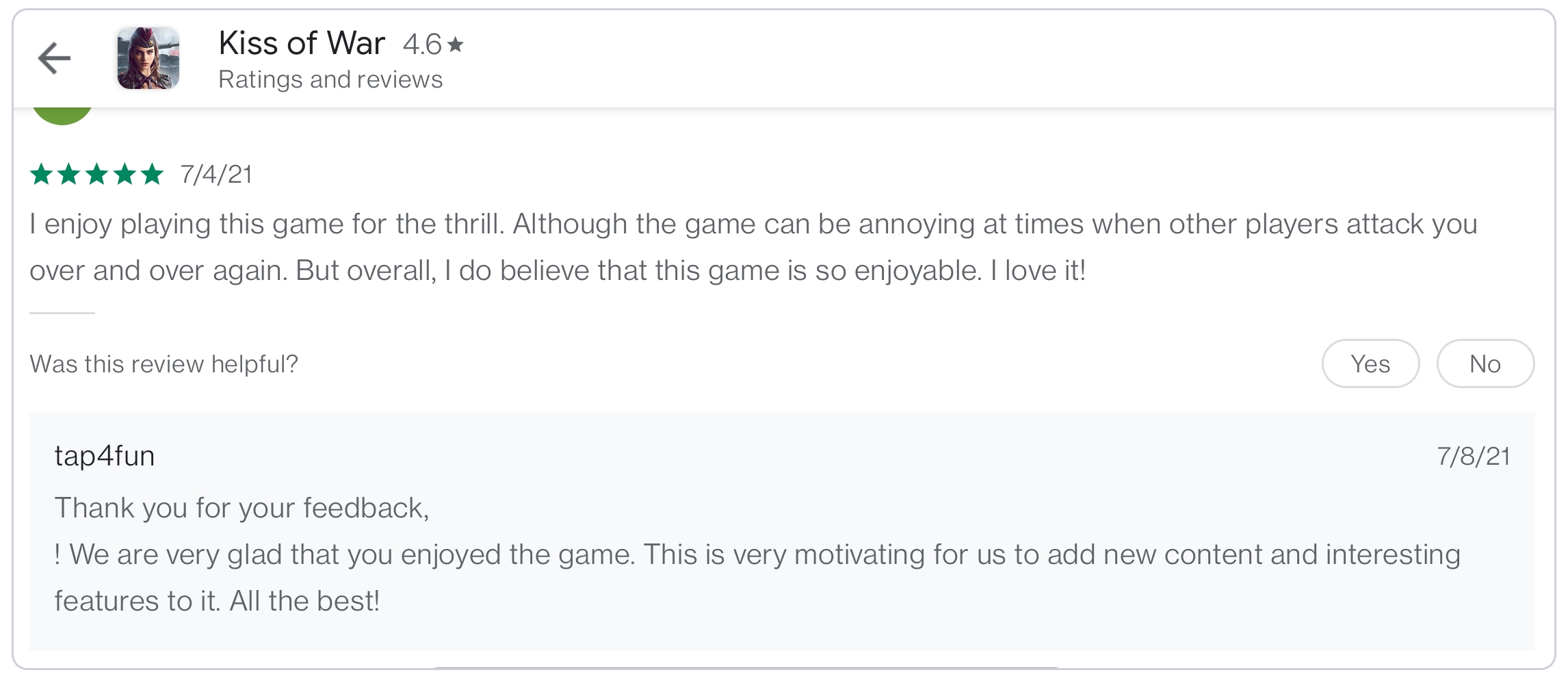
However, if you take the time to check your greatest reviews and react and respond to them, you can increase the chances of getting featured in the “preview” widget.
This way, your visitors will see a long and encouraging positive review instead of a short and boring one.
7. Deleting Bad Reviews & ASO Ratings
On iOS, when you release a new version, you can reset your ASO Rating.
However, on a regular basis, you can’t just simply delete them. Unless that specific Review is against Google’s or Apple’s policies, you can’t report them. Even if they do, it will take you several weeks until the App Stores reach any conclusion.
Though you may try to clean up some reviews that you think may affect your ASO Conversion, there are other ways to turn a bad review into a good one.
Start by replying to negative customer reviews.
Instead of writing each reply every new bad review emerges, we recommend you take some time analyzing the most common topics that users comment on. Then, draft a few generic texts with placeholders. Save them to, later on, copy-paste and personalize your reply. That will help you save lots of time.
Open lines of communication with your unhappy users and publicly commit to improving the issue they’re facing. As a result, you will make them feel connected to you and have more empathy.
Reviews are just another way to engage with your community, and when people feel heard, they can even turn a bad review into a 5-star rating.
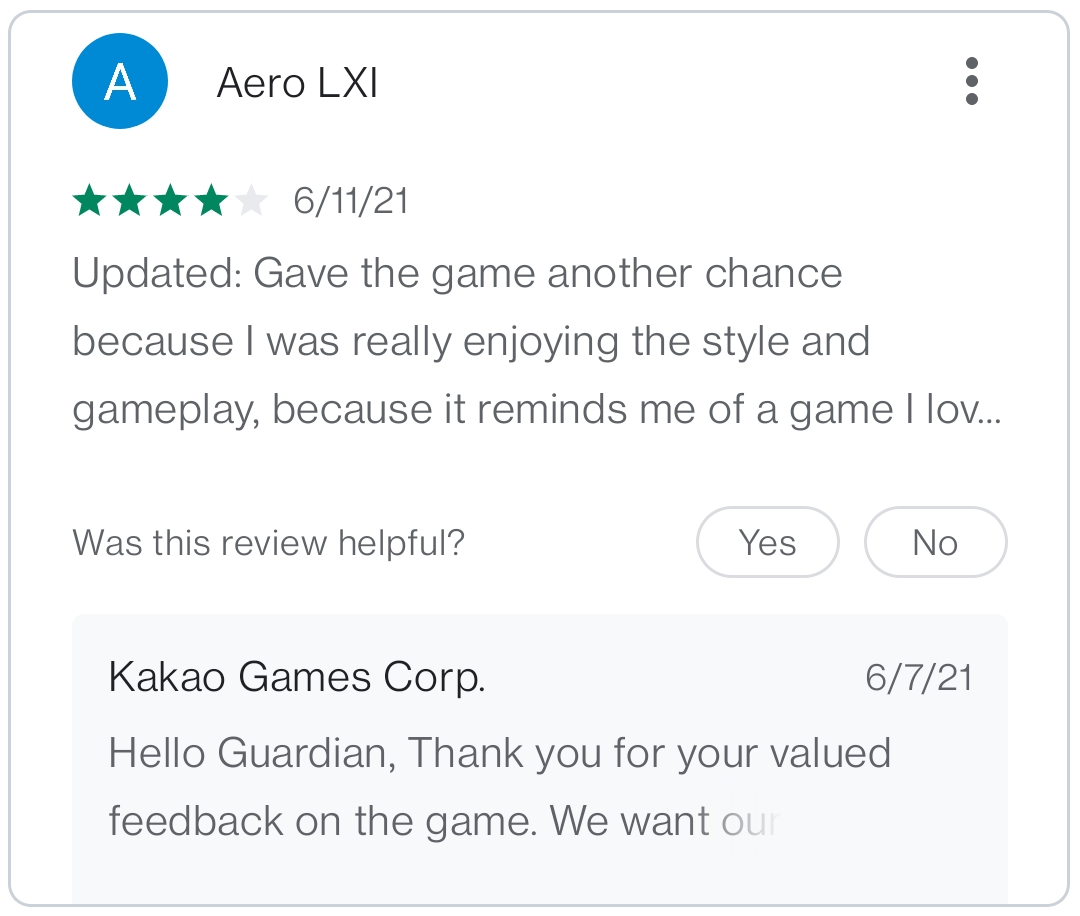
8. Rewards in exchange for Positive Reviews?
NO!
Don’t offer a reward in exchange for a positive rating or review. That’s against the Terms of Service of Google & Apple.
Even if you think you can do it without them noticing, these practices will attract customers you don’t want, such as:
- Customer mercenaries: Harm the community it took you so long to build.
- Predators: users that create bots. You may get black-listed by the Google & Apple algorithm.
- Vigilantes: They will point out your shady practices and harm your reputation.
Some ASO “Experts” sometimes encourage app creators to offer incentives in exchange for reviews, knowing all the risks and difficulties for a busy indie developer. Most of the time, these practices end in regrets.
We can’t forbid you from doing those practices: it’s your choice. But we don’t recommend it.
Managing your ASO Ratings and Reviews
Your ASO Ratings and Reviews reflect the quality of your mobile app or game.
If you’re getting poor ratings and bad reviews, maybe you should put your ASO Rating & Review Strategy on pause. Instead, focus on fixing these bugs or mechanics that people are complaining about. Then, improve your app quality and release an update to extinguish the fire.
Suppose you’re aware that a particular Android version causes many issues with your app. Segment users with that bugged version, and avoid sending them a “rate my app” pop-up. Or even better, let them know that you (or your developer team) are aware of any potential bugs, and you’re working on solving them, even before they get salty and put a bad Review on your App Store Page.
You can calm the spirits by answering them that you’re working on the problem. Drive them to an internal support platform where you can handle all their complaints before they escalate.
Only when you’re confident again with your app come back to your users and bring them the good news.
Follow our tips and, in time, you will find that your app starts getting higher ratings and better reviews.

Looking for an extra push to your ASO Strategy? Register our Appodeal Accelerator Program at NO entry cost. Receive funds, resources, and dedicated marketing support to help you boost your organic reach. || Self-publish your apps & games, and keep 100% of your IP (Intellectual Property) rights!
